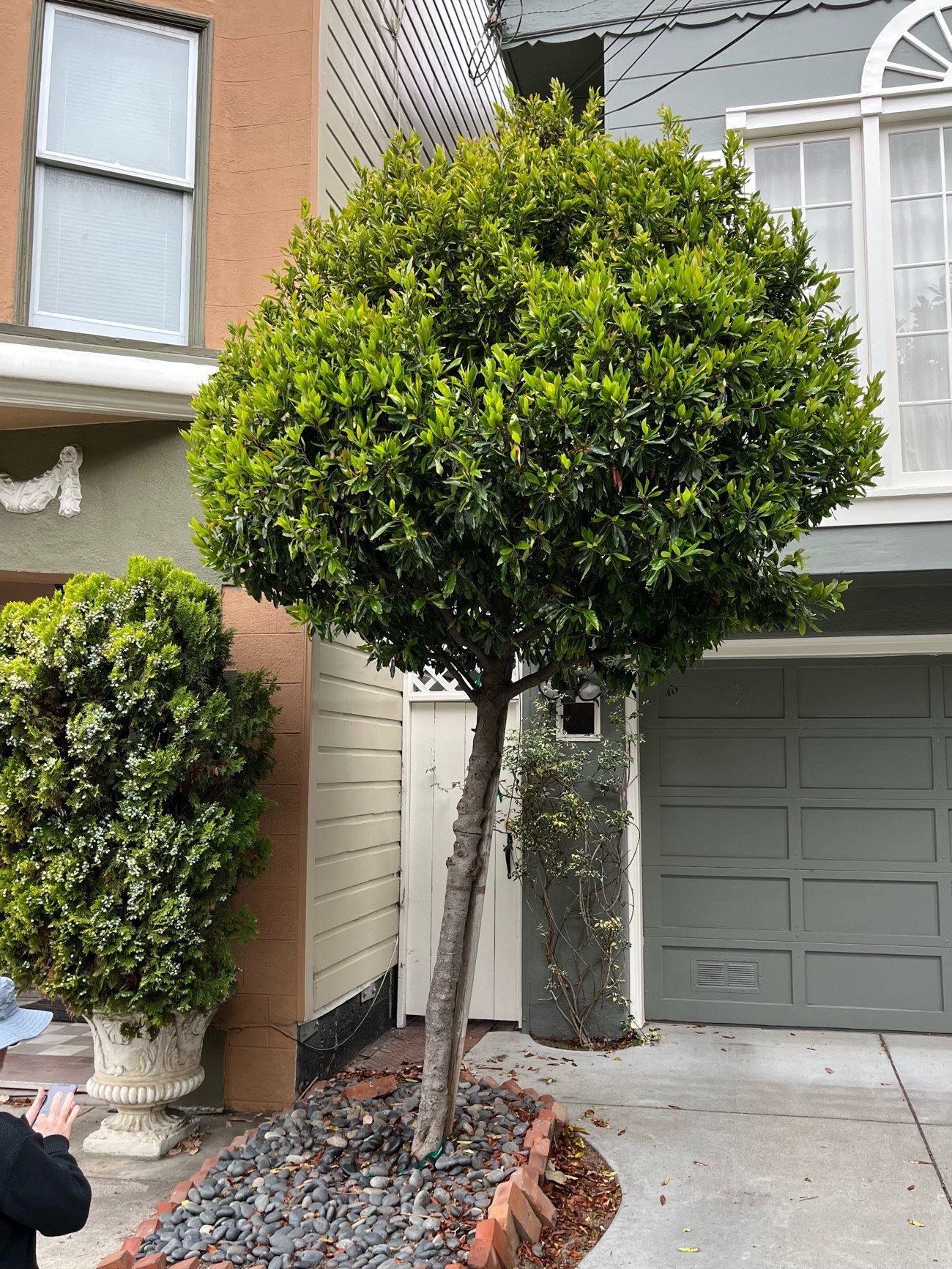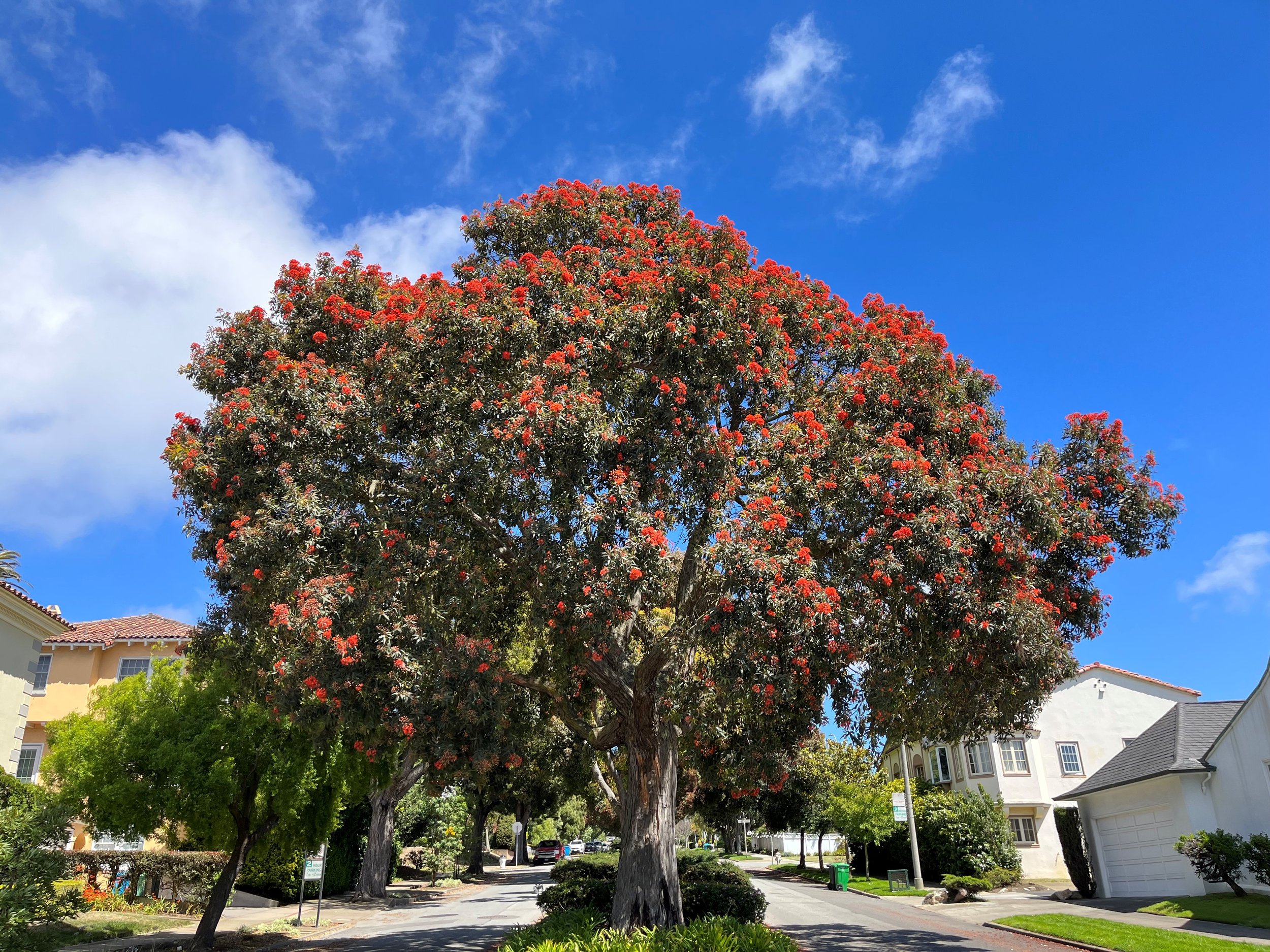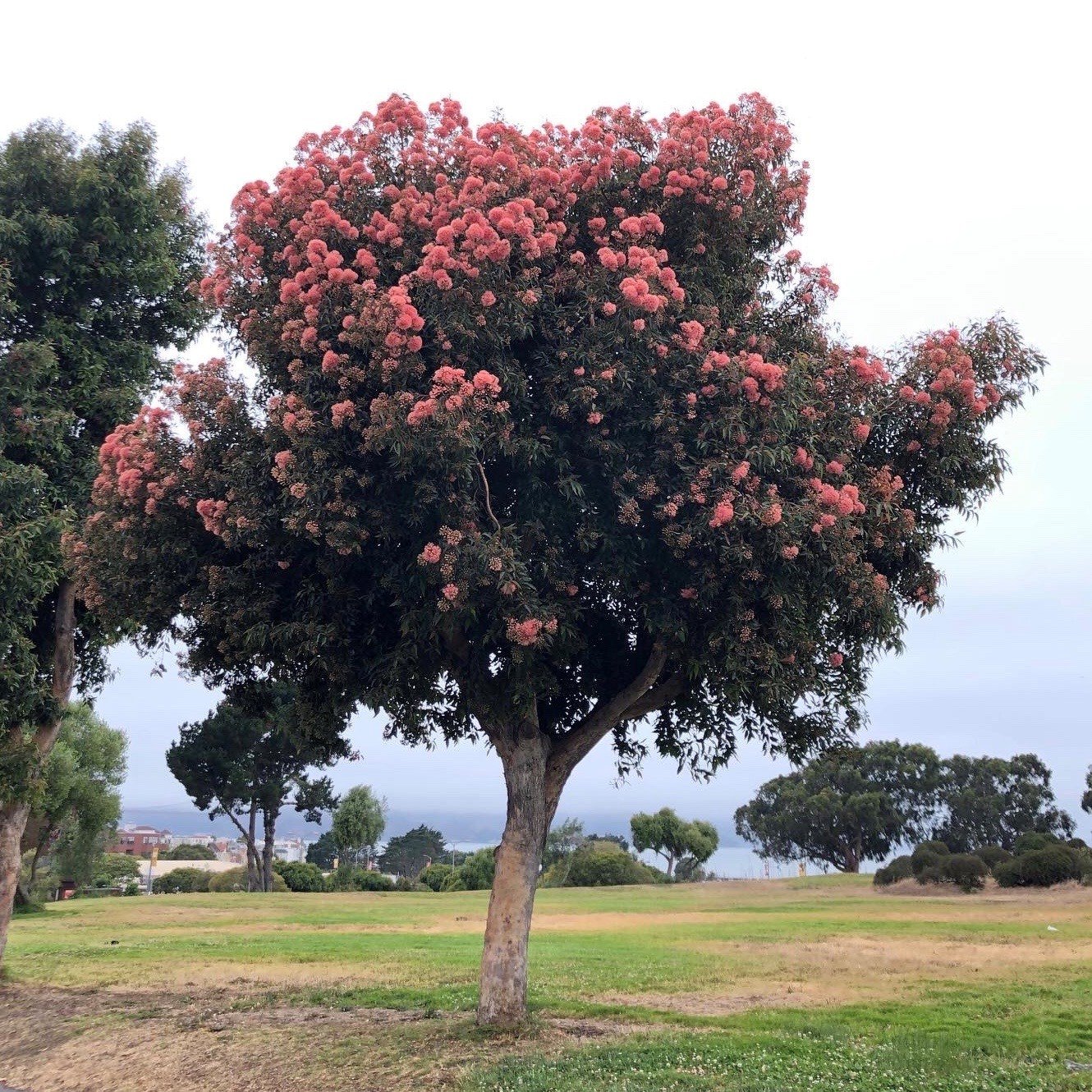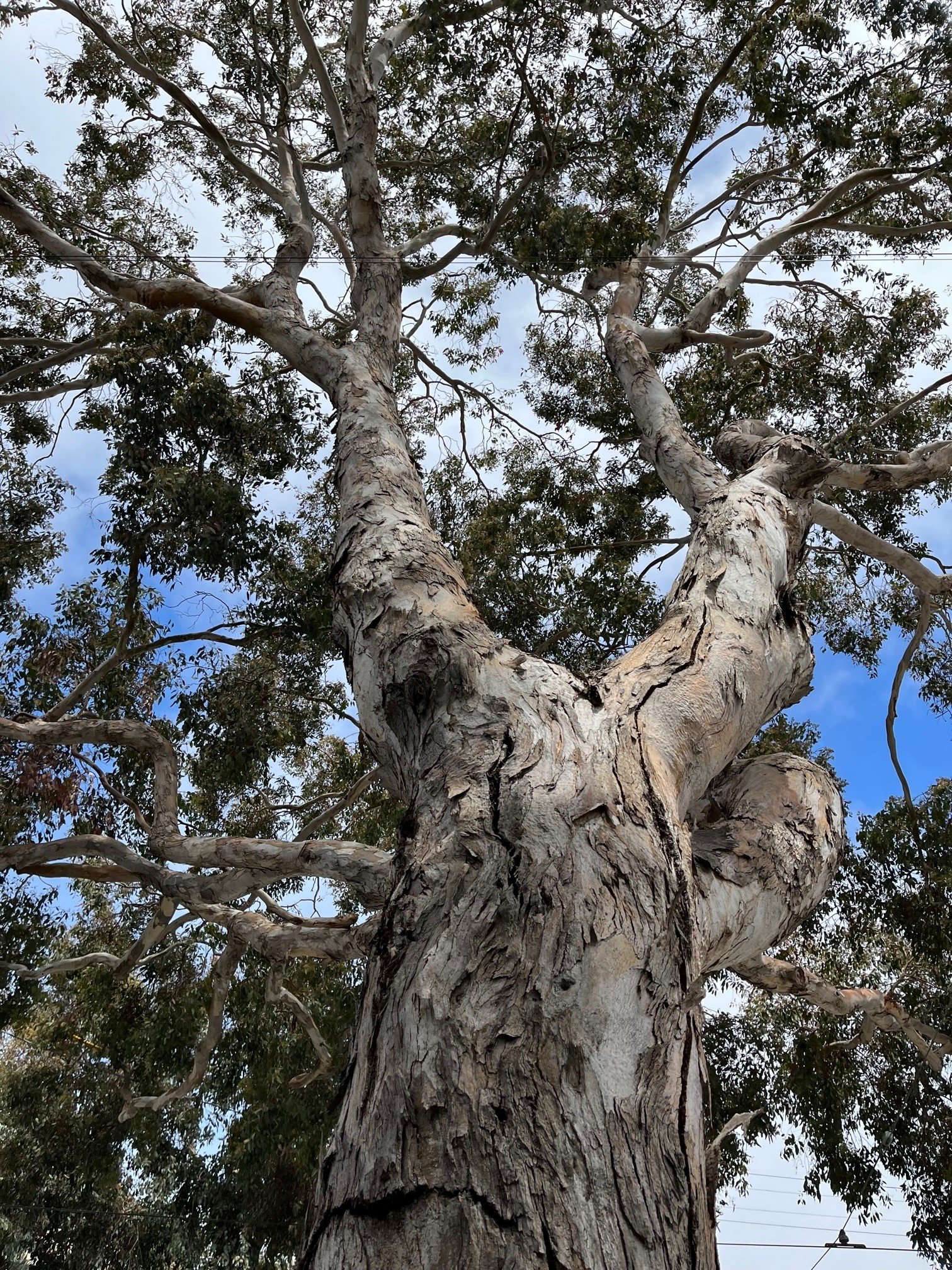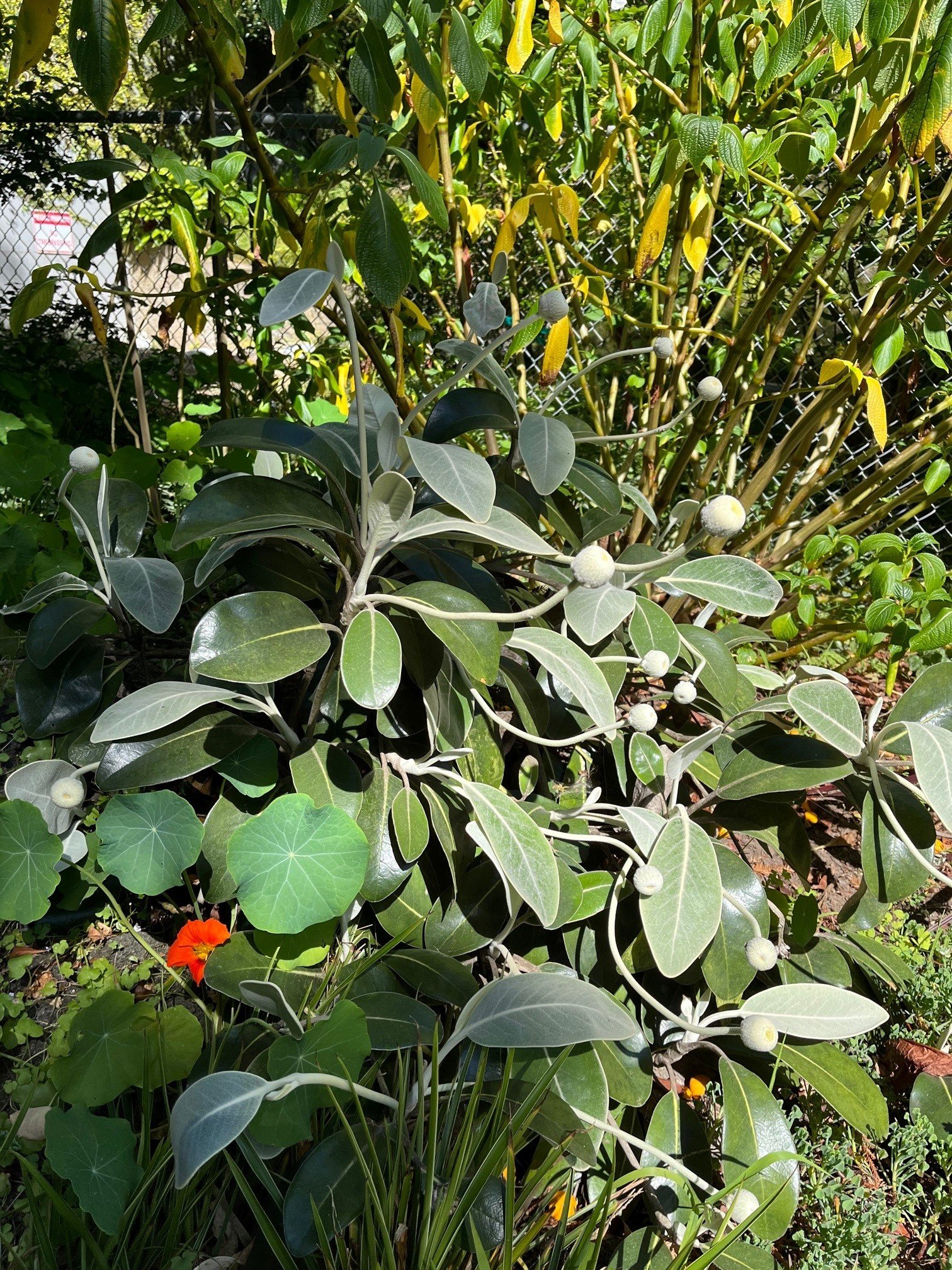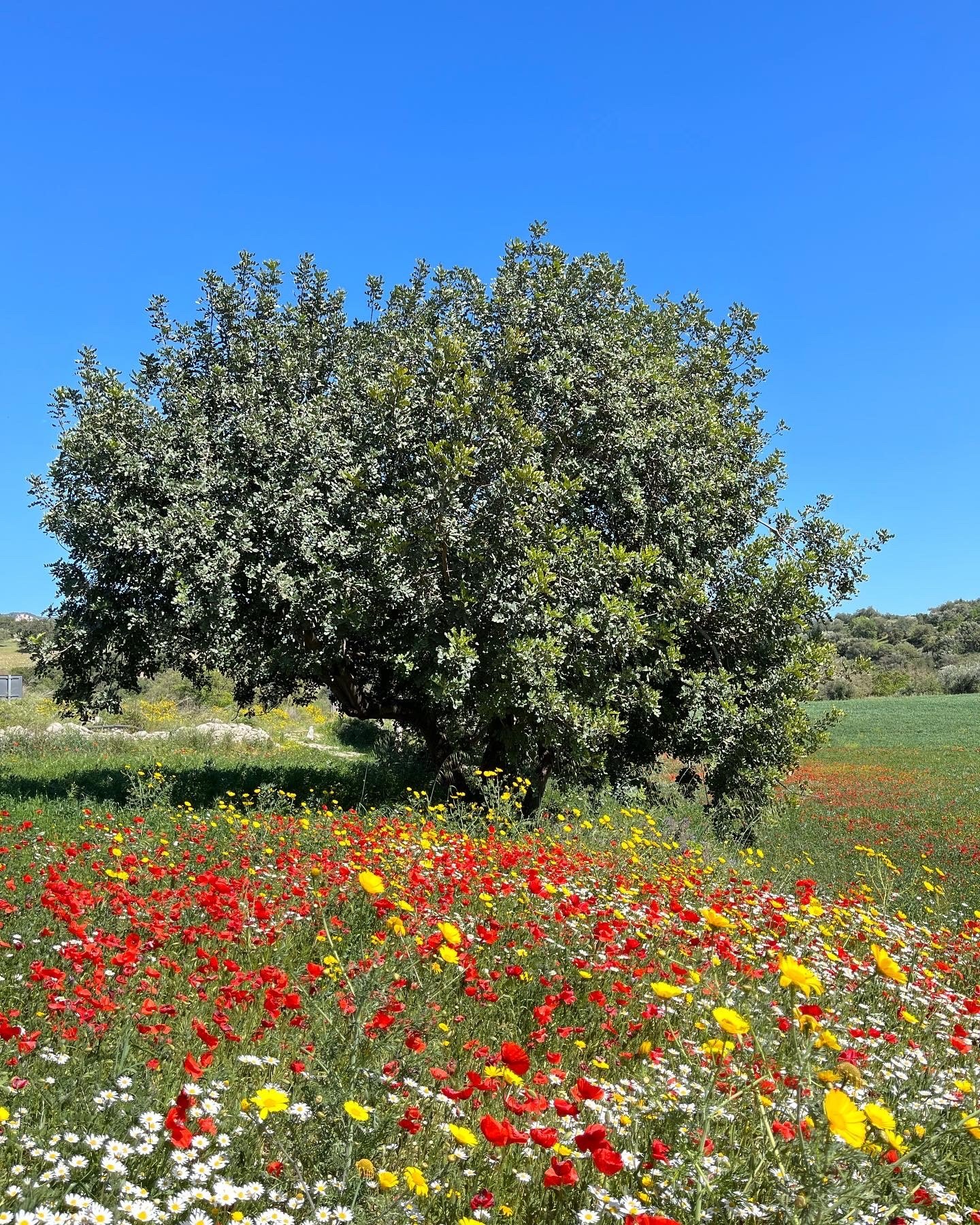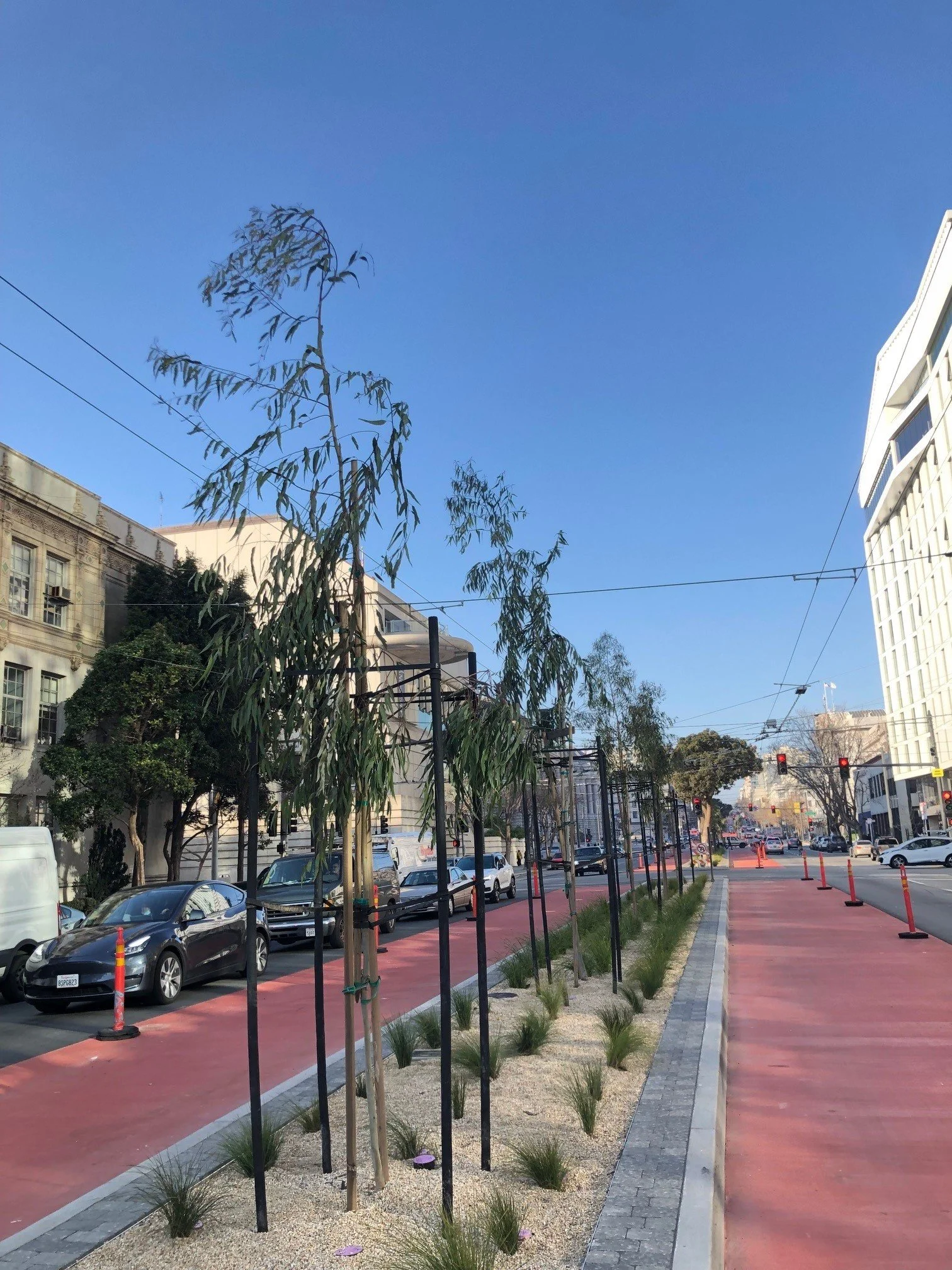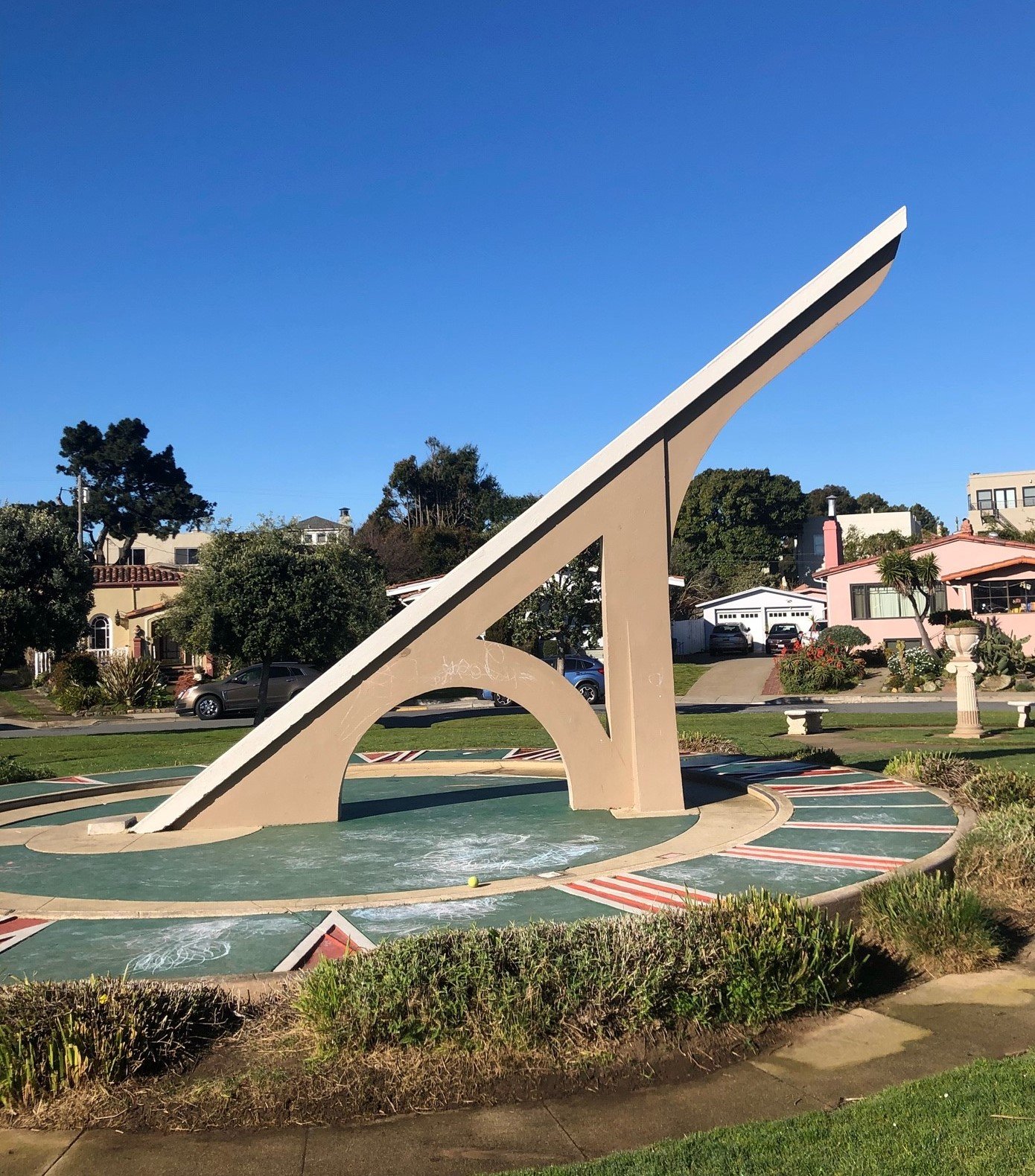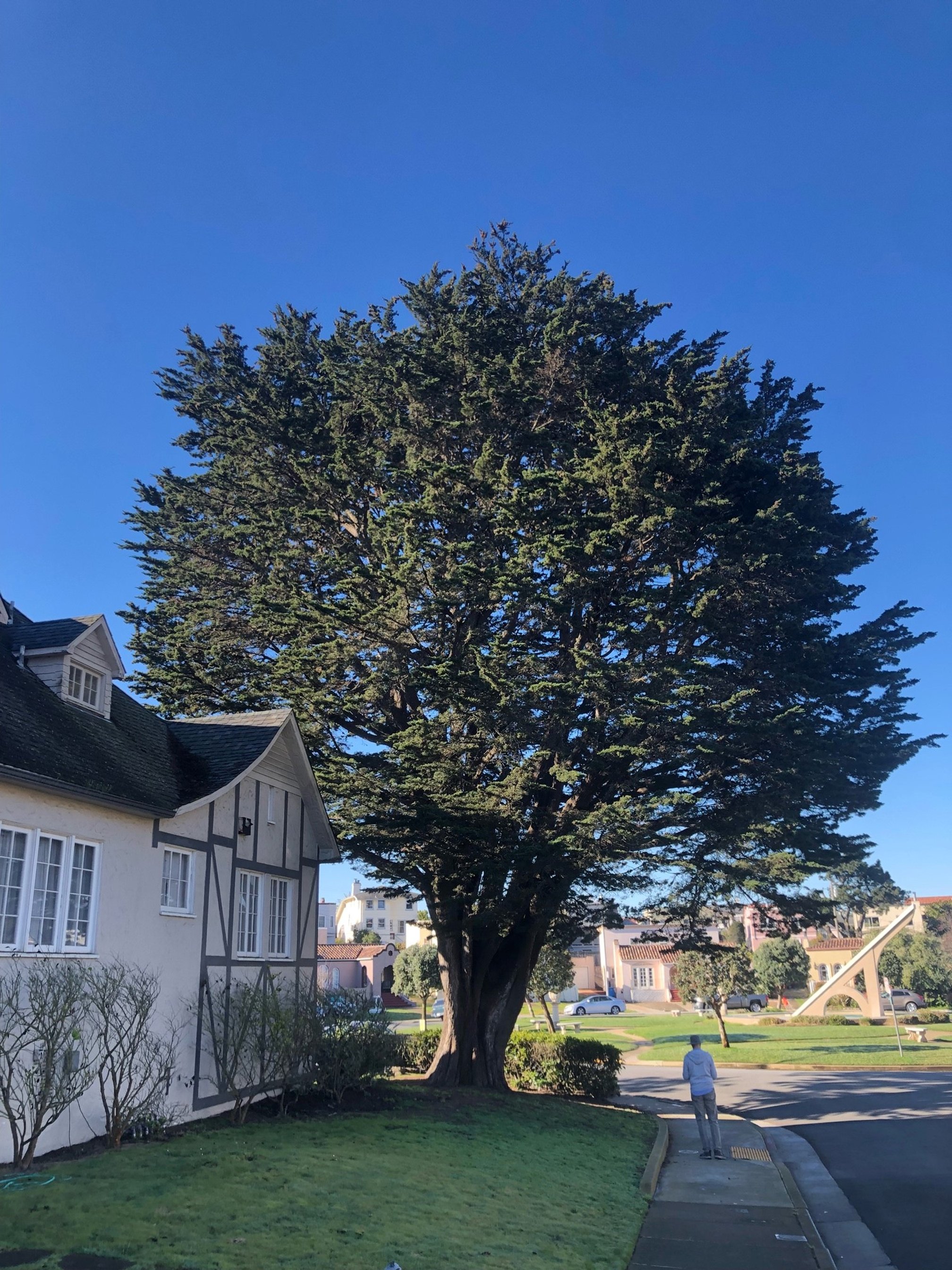Sutro Heights Tree Tour (11-13-22)
On a simply magnificent autumn day, the tree geeks headed to the western most edge of the Richmond District, to a neighborhood known as Sutro Heights, named after Adolph Sutro, who built a mansion on the bluff overlooking the Cliff House and Ocean Beach. The park that remains where the mansion stood is filled with trees, many planted by Sutro himself. The conditions can be challenging for tree growth in this area: persistent fog and wind, sandy soils, and salty air. We were surprised to discover so many trees along the streets next to the park, demonstrating the adaptability of some of our most common trees—both native and introduced.
Today’s walk begins at the intersection of Geary Boulevard and 48th Avenue, one block south of Seal Rock Inn and the entrance to the Lands End Visitor Center parking lot; it’s also at the terminus of the 38-Geary bus line. The walk leads south on 48th to Anza Street, east on Anza to 46th Avenue, south on 46th to Balboa Street, west on Balboa to 47th Avenue, north on 47th to Sutro Heights Avenue, west on Sutro Heights to 48th, and finally north on 48th to the start of the walk at Geary. This walk is about two miles in length.
Numbered trees are labeled with common and scientific names and country of origin, all written in white chalk on the sidewalk; accompanying numbers, in blue, run from 1 to 32. White arrows on the pavement provide directions whenever a turn is needed.
The street addresses provided below will help when the chalk has faded. Most of the trees on this walk are planted in pockets in the sidewalk pavement; a few are planted within the front gardens of the homes along the route; and a number are noted inside Sutro Heights Park, on the west side of 48th.
48th Avenue, Geary to Anza, east side
Mexican fan palm (Washingtonia robusta)
1. 500 - 48th Mexican fan palm (Washingtonia robusta), Baja California & Sonora, Mexico (2 trees on Geary; note the beautifully tended shrub bed beneath the palms)
2. 500 - 48th Yew-plum pine, Buddhist pine, or Japanese podocarpus (Podocarpus macrophyllus), Japan & China (2 trees flanking the garage door)
3. 510 - 48th Kwanzan flowering cherry (Prunus serrulata ‘Kwanzan’), E Asia (watch for the big pink flowers on this young tree in April)
4. 558 - 48th Hollywood juniper (Juniperus chinensis ‘Torulosa’ or ‘Kaizuka’), E Asia (3 trees at this address, but many specimens of this needle-leaf evergreen can be seen along 48th)
Please don’t do this!
5. 566 - 48th New Zealand Christmas tree, pōhutukawa in Māori (Metrosideros excelsa), New Zealand (we have no explanation for the odd pruning of this tree)
6. 594 - 48th Cabbage tree or tī kōuka in Māori (Cordyline australis), New Zealand (there are many specimens of this tree in the neighborhood, including the ones across the street)
Anza Street, 48th to 47th, north side
7. 594 - 48th Cajeput tree (Melaleuca quinquenervia), E Australia (tree is on Anza; feel its spongy bark)
8. 594 - 48th Pink melaleuca (Melaleuca nesophila), W Australia (peeking over the rear fence)
9. 5624 Anza Giant yucca (Yucca gigantea, formerly Y. elephantipes), Mexico & Central America
Canary Island date palm (Phoenix canariensis)
10. 595 - 47th Canary Island date palm (Phoenix canariensis), Canary Islands, Spain (tree is on Anza; a young specimen, having barely developed a trunk; this is the species seen on Market Street and along the Embarcadero)
Anza Street, 47th to 46th, north side
11. 5546 Anza Marina strawberry tree (Arbutus ‘Marina’), hybrid of Mediterranean species (3 trees; this hybrid was first introduced in San Francisco)
12. 5549 Anza Willow-leaf peppermint (Eucalyptus nicholii), SE Australia (across the street)
13. 5549 Anza Electric Pink New Zealand cabbage tree (Cordyline ‘Electric Pink’), hybrid of NZ species (several trees at this address, notable for their pink leaves)
14. 5500 Anza Holm oak (Quercus ilex), Mediterranean Basin (a surprisingly uncommon tree in SF, despite its adaptability to our climate)
At 5501 Anza you’ll find the oldest tree we’ve ever encountered on our tours!
15. 5501 Anza Water gum (Tristaniopsis laurina), E Australia (this tree grows in stream-side locations in the wild, hence the common name; SF’s most commonly planted street tree)
Anza Street at 46th, south side
16. 5501 Anza Southern magnolia (Magnolia grandiflora), SE USA
17. 5501 Anza Purple-leaf plum (Prunus cerasifera), Eurasia (formerly SF’s most planted street tree; totally without leaves through fall and winter, it is usually in flower by early February)
46th Avenue, Anza to Sutro Heights, west side
18. 5501 Anza New Zealand tea tree (Leptospermum scoparium), New Zealand (tree is on 46th)
19. 615 - 46th Strawberry tree (Arbutus unedo), Ireland to Portugal and the Mediterranean
New Zealand Christmas tree, pōhutukawa in Māori (Metrosideros excelsa)
20. 625 - 46th New Zealand Christmas tree, pōhutukawa in Māori (Metrosideros excelsa), New Zealand (the yellowish aerial roots suggest that the flowers on this tree may be yellow)
21. 647 - 46th Monterey cypress (Hesperocyparis macrocarpa), Carmel, CA (several on Sutro Heights Avenue, an one of the three most commonly planted trees in SF’s parks)
46th Avenue, Sutro Heights to Balboa, west side
22. 103 Sutro Heights Drooping prickly pear (Opuntia monacantha), Argentina, Uruguay (these cacti are not usually thought of as trees, but note the single large trunk on this one)
23. 4500 Balboa Primrose tree (Lagunaria patersonia), Australia & S Pacific Islands (4 trees on 46th; note the subtle variation in flower color)
Primrose tree (Lagunaria patersonia)
Balboa Street, 46th to 47th, north side
24. 4508 Balboa Dragon tree (Dracaena draco), Canary Islands, Cape Verde, Madeira, and W Morocco (cool tree, but too rare in SF; this one and two in the next block were planted about fifteen years ago)
Dragon tree (Dracaena draco)
25. 4530 Balboa Australian tea tree (Leptospermum laevigatum), SE Australia
26. 4550 Balboa Torbay Dazzler cabbage tree (Cordyline australis ‘Torbay Dazzler’), New Zealand (2 young trees)
47th Avenue, Balboa to Sutro Heights, west side
27. 681 - 47th Monterey cypress (Hesperocyparis macrocarpa), Carmel, CA (one of the three most commonly planted trees in SF’s parks)
Giant bird-of-paradise (Strelitzia nicolai)
28. 667 - 47th Giant bird-of-paradise (Strelitzia nicolai), E South Africa (watch for the huge, blue and white flowers as this tree matures)
29. 101 Sutro Heights Hybrid pōhutukawa in Māori (Metrosideros excelsa x kermadecensis), New Zealand mainland and Kermadec Islands (tree is on 47th; the rounded leaves, relatively few aerial roots, and winter flowers suggest that this tree is a hybrid)
47th Avenue at Sutro Heights, northwest corner
30. 645 - 47th Peach tree (Prunus persica), China (this might actually be a nectarine)
48th Avenue at Sutro Heights, west side
31. 645 - 48th Blue trumpet flower (Iochroma cyaneum), Andes of S America (multi-trunked tree on left against house) and English holly (Ilex aquifolium), Eurasia & N Africa (glossy-leafed tree on the right against the house)
32. 641 - 48th Monterey pine (Pinus radiata), CA native: Año Nuevo, Monterey, Cambria, plus Cedros and Guadalupe islands, MX (most widely planted coniferous tree in the world, mostly for lumber)
**Cross to the east side of 48th and continue north for two blocks to the start of the walk at Geary**
*Note the sidewalk art at 626 - 48th :)
*At the northeast corner of 48th and Anza, look to the northwest, across the street into Sutro Heights Park. The park is filled with a good variety of trees, many of the visible from this vantage point, including plume acacia (Albizzia), Monterey cypress (Hesperocyparis macrocarpa), Norfolk Island pine (Araucaria heterophylla), Monterey pine (Pinus radiata), Canary Island date palm (Phoenix canariensis), Sydney golden wattle (Acacia longifolia), karo tree (Pittosporum crassifolium), Mexican fan palm (Washingtonia robusta), and Tasmanian blue gum (Eucalyptus globulus). All of these trees were in common use at the time Adolph Sutro built his mansion on the bluff and planted these trees; they are particularly adapted to seaside conditions of persistent fog and winds, sandy soils, and salty air.
This walking tour of Noe Valley’s street trees was organized by Mike Sullivan, author of The Trees of San Francisco and webmaster of www.sftrees.com; Jason Dewees, horticulturist at Flora Grubb Gardens and author of Designing with Palms; and Richard Turner, retired editor of Pacific Horticulture magazine . You can follow Mike and Jason on their tree-themed Instagram pages at @sftreeguy and @loulufan. One other great book on San Francisco trees, while you’re at it: Elizabeth McClintock’s Trees of Golden Gate Park, edited by Richard Turner. If you’re a tree enthusiast, buy all three books!”


















